Artemisia tridentata
| Artemisia tridentata | |
|---|---|
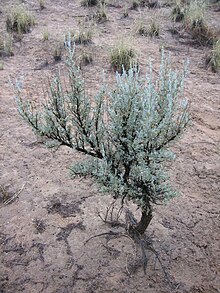
| |
| Sagebrush growing in San Juan County, New Mexico | |
| Scientific classification | |
| Kingdom: | Plantae |
| Clade: | Tracheophytes |
| Clade: | Angiosperms |
| Clade: | Eudicots |
| Clade: | Asterids |
| Order: | Asterales |
| Family: | Asteraceae |
| Genus: | Artemisia |
| Species: | A. tridentata
|
| Binomial name | |
| Artemisia tridentata | |
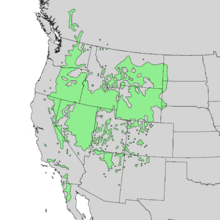
| |
| Natural range of Artemisia tridentata | |
| Synonyms[1] | |
|
Synonymy
| |
Artemisia tridentata, commonly called big sagebrush,[2] Great Basin sagebrush[2] or simply sagebrush (one of several related species of this name), is an aromatic shrub from the family Asteraceae.
It grows in arid and semi-arid conditions, throughout a range of cold desert, steppe, and mountain habitats in the Intermountain West of North America. Big sagebrush and other Artemisia shrubs are the dominant plant species across large portions of the Great Basin.
Sagebrush provides food and
Native Americans have used the plant medicinally. It is also useful as firewood.
Description
Big sagebrush is a coarse, many-branched, pale-grey shrub with yellow

The species has a strong pungent fragrance (especially when wet) due to the presence of
The plant flowers in the late summer or early fall.[12] The small yellow flowers are in long, loosely arranged tubular clusters.[13] The fruits are seed-like and have a small amount of hairs on the surface.[11]
Big sagebrush can also reproduce through sprouts, which shoot up from the underground rhizome. The sprouts are an extension of the parental plant while seedlings are completely individualistic to any other plant. Among these two strategies, the seedlings need more moisture for germination and early survival. This is due to the sprouts being connected to already healthy and associated plants while the new seedlings will start anew.[citation needed]
Chemistry
Sagebrush essential oil contains approximately 40% l-camphor; 20%
Taxonomy
Much discussion and disagreement revolves around the question of how to divide the species into varieties and subgenera. The following subspecies are accepted by some authors, though others advocate different systems.[5][14][15]
- A. tridentata subsp. tridentata ("basin big sagebrush")
- A. tridentata subsp. vaseyana ("mountain big sagebrush")
- A. tridentata subsp. wyomingensis ("Wyoming big sagebrush") – Found in the drier portions of the sagebrush steppe. Shrub density is generally less than 1 plant/m2, with little herbaceous cover surrounding the shrub.[16]
- A. tridentata subsp. xericensis ("scabland big sagebrush")
- A. tridentata subsp. spiciformis ("subalpine big sagebrush")
- A. tridentata subsp. parishii ("Parish's big sagebrush")
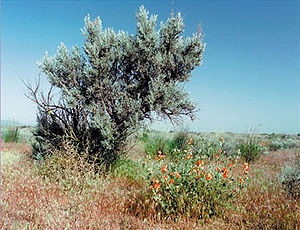
Distribution and habitat
Artemisia tridentata grows in arid and semi-arid conditions, throughout the
Ecology
Sagebrush provides food and
The terpenoid compounds in big sagebrush are thought to ward off herbivores. These oils, at high concentrations, are toxic to the symbiotic bacteria in the rumen of some ruminants like deer and cattle.[26][27] Pronghorn are the only large herbivore to browse sagebrush extensively.[28] Damage to sagebrush plants caused by grazing herbivores results in the release of volatile chemicals, which are used to signal a warning to nearby plants, so that they can increase the production of repellent chemical compounds. This plant-to-plant communication can take place at distances of up to 60 cm (23+1⁄2 in).[29]
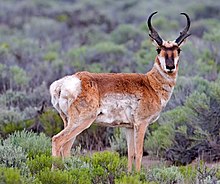
Several major threats exist to sage brush ecosystems, including human settlements, conversion to
Galls
This species is host to the following insect induced galls:
- Eutreta diana fly bud gall
- Eutreta divisa fly bud gall
- Eutreta oregona fly bud gall
- Eutreta pollinosa fly bud? gall
- Oxyna aterrima fly bud gall
- Rhopalomyia (ampullaria, anthoides, brevibulla,calvipomum, conica, cramboides,culmata, florella, gossypina, hirticaulis, hirtipomum, lignea, lignitubus, mammilla, medusa, medusirrasa, nucula, obovata, occidentalis, pomum, rugosa, tridentatae, tubulus, tumidibulla, tumidicaulis) Various gall midges.
-
Eutreta diana
-
Rhopalomyia calvipomum
-
Rhopalomyia conica
-
Rhopalomyia pomum
-
Rhopalomyia medusa
Uses
The Cahuilla used to gather large quantities of sagebrush seed and grind it to make flour.[10][38] The main modern use is as firewood, with the wood's oils being particularly flammable.[24]
Medicinal
The plant's active medicinal constituents include camphor, terpenoids, and tannins.[6]
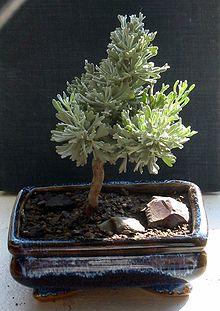
It is used as a
The
Among the Zuni people, an infusion of the leaves is used externally for body aches. The infusion is also taken as a cold medicine. It is also placed in shoes to treat athlete's foot, fissures between toes, and as a foot deodorant.[42]
Culture
Artemisia tridentata is the
See also
- Great Basin Desert
- Medicinal plants of the American West
References
- ^ The Plant List, Artemisia tridentata Nutt.
- ^ ISBN 978-0762780334, p. 264.
- ISBN 9780774805643.
- ISBN 9780874171129.
- ^ ISBN 9780521559867.
- ^ ISBN 9780857293237.
- ISBN 9780520227750.
- ISBN 9780804700061.
- ISBN 9780520221093.
- ^ ISBN 9780520032675.
- ^ ISBN 9780888643193.
- ISBN 9780520010505.
- ISBN 9780878423590.
- ^ "USDA Plants Database" (PDF). Plants.usda.gov. Retrieved 16 March 2022.
- ^ "Artemisia tridentata in Flora of North America @ efloras.org". Efloras.org. Retrieved 16 March 2022.
- ISBN 9780520249554.
- ISBN 9783540531135.
- ISBN 9780874171129.
- ISBN 9780521363778.
- ^ "Biota of North America Program 2014 county distribution map". Bonap.net. Retrieved 16 March 2022.
- ^ "Artemisia tridentata Calflora". Calflora.org. Retrieved 16 March 2022.
- ISBN 9780520086890.
- ISBN 9780520249554.
- ^ ISBN 0394731271.
- ISBN 9780824756949.
- ^ Nagy, JG and RP Tengerdy. 1968. Antibacterial action of essential oils of Artemisia as an ecological factor: II. Antibacterial action of the volatile oils of Artemisia tridentata (big sagebrush) on bacteria from the rumen of mule deer" Applied and Environmental Microbiology 16(3) 441–44.
- ISBN 9789086861842.
- ISBN 9780231111560.
- ISBN 9781461417033.
- ISBN 9780520267114.
- ISBN 9780520270060.
- PMID 11381951.
- ISBN 9780471116066.
- ISBN 9780471767794.
- Ephedraand bunchgrasses, which can root-sprout after a fire.
- ISBN 9780295985961.
- ^ Vale, Thomas (1975). "Invasion of big sagebrush (Artemisia tridentata) by white fir (Abies concolor) on the southeastern slopes of the Warner Mountains, California". Western North American Naturalist. 35 (3).
- ISBN 9780804703659.
- ISBN 0878423591 [page needed]
- ISBN 9780186516465.
- ISBN 9780195370010.
- ^ Camazine, Scott and Robert A. Bye 1980 A Study Of The Medical Ethnobotany Of The Zuni Indians of New Mexico" Journal of Ethnopharmacology 2:365–88 (p. 374)
External links
- "Artemisia tridentata". Calflora. Berkeley, California: The Calflora Database.
- Artemisia tridentata in the CalPhotos photo database, University of California, Berkeley
- "Artemisia tridentata". Plants for a Future.
- GIS Database for Sage Grouse and Shrubsteppe Management in the Intermountain West
- Jepson eFlora (TJM2) treatment of Artemisia tridentata
- The Sagebrush Sea






